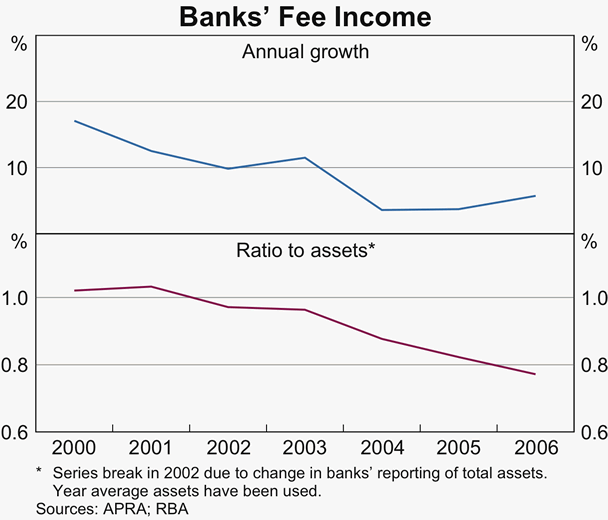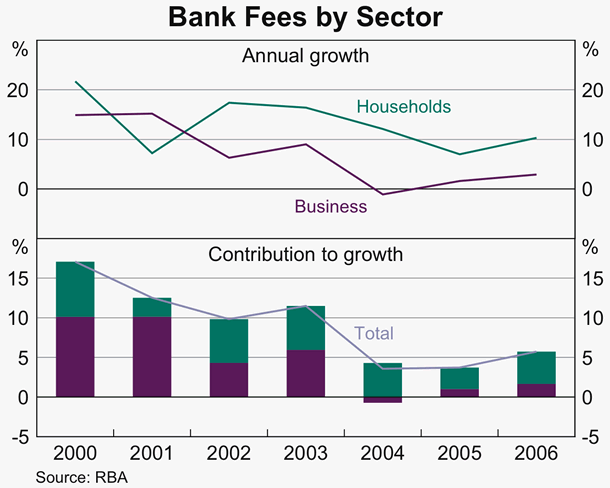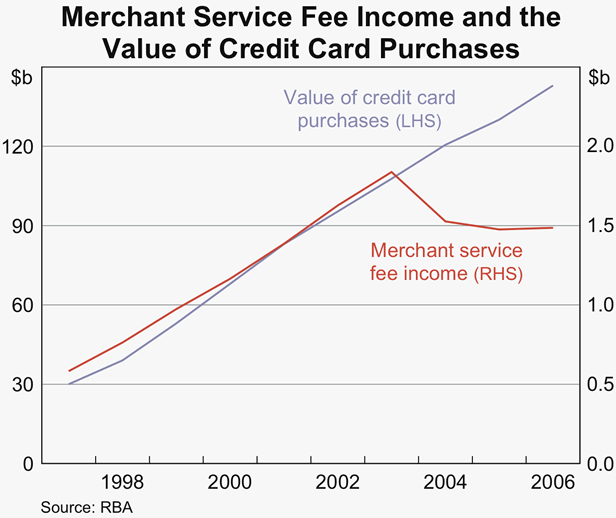Bulletin – May 2007 Banking Fees in Australia
- Download 48KB
Since 1997 the Reserve Bank has undertaken an annual survey of the fee income commercial banks earn from their domestic banking operations.[1] The latest survey, relating to banks' 2006 financial year, covered 18 banks accounting for more than 90 per cent of the total assets of the banking sector in Australia.[2]
Fees from Banking Activities
Total domestic fee income of participant banks grew by 6 per cent in 2006, to $9.8 billion (Graph 1, Table 1). Growth in fee income was slightly higher than in the previous two years, but remains well below the 13 per cent average annual growth rate seen between 2000 and 2003. In line with the trend of the past five years, the growth in fee income was less than the growth in the banks’ balance-sheet assets, with the result that the ratio of fee income to assets fell again.

| Businesses | Households | Total | ||||||
|---|---|---|---|---|---|---|---|---|
| $ million | Annual change Per cent |
Share of total Per cent |
$ million | Annual change Per cent |
Share of total Per cent |
$ million | Annual change Per cent |
|
| 2000 | 4,164 | 15 | 67 | 2,083 | 22 | 33 | 6,247 | 17 |
| 2001 | 4,797 | 15 | 68 | 2,233 | 7 | 32 | 7,029 | 13 |
| 2002 | 5,099 | 6 | 66 | 2,620 | 17 | 34 | 7,720 | 10 |
| 2003 | 5,558 | 9 | 65 | 3,049 | 16 | 35 | 8,607 | 11 |
| 2004 | 5,496 | −1 | 62 | 3,418 | 12 | 38 | 8,915 | 4 |
| 2005 | 5,580 | 2 | 60 | 3,660 | 7 | 40 | 9,239 | 4 |
| 2006 | 5,741 | 3 | 59 | 4,035 | 10 | 41 | 9,776 | 6 |
|
Source: RBA |
||||||||
Fee income from households increased by 10 per cent in 2006 while fee income from businesses rose by 3 per cent (Graph 2). Fee income from households has risen at a faster pace than fee income from businesses for most of the survey's history. One reason for this is that households have been accounting for an increasing share of banks' operations. Second, growth in fees from businesses has been restrained in recent years by the credit card reforms introduced in late 2003 (see below). As a result, the share of fee income derived from households has risen by around 10 percentage points over the past decade. As in recent years, the growth in fee income from both households and businesses has been due largely to increases in the volume of banking services rather than increases in unit fees.

Businesses
Banks' fee income from businesses rose by 3 per cent to $5.7 billion in 2006 (Table 2). Bank bill fee income, which includes charges for arranging bill facilities and accepting or endorsing bills, increased by 6 per cent and accounted for almost half of the growth in business fee income. The increase in bank bill fees reflected strong growth in bank bill issuance rather than increases in unit fees.
| 2003 | 2004 | 2005 | 2006 | Growth 2006 Per cent |
Average growth 2000–2005 Per cent |
|
|---|---|---|---|---|---|---|
| Deposits | 710 | 737 | 754 | 757 | 0 | 4 |
| Loans | 1,351 | 1,485 | 1,556 | 1,618 | 4 | 7 |
| Merchant service fees | 1,826 | 1,516 | 1,468 | 1,481 | 1 | 5 |
| Bills | 1,077 | 1,120 | 1,151 | 1,224 | 6 | 4 |
| Other | 594 | 639 | 651 | 661 | 2 | 14 |
| Total | 5,558 | 5,496 | 5,580 | 5,741 | 3 | 6 |
|
Source: RBA |
||||||
Merchant service fee income rose by just 1 per cent in 2006, with a decline in average merchant service fees largely offsetting a 10 per cent increase in the value of credit card purchases (Graph 3). Following the Reserve Bank's credit card reforms in late 2003, merchant service fees paid on credit card purchases have fallen from 1.4 per cent to 0.85 per cent, reflecting a fall in interchange fees and strong competition among banks for merchant business.

Fee income from business loans increased by 4 per cent, slower than in recent years. This is despite business credit growing at its fastest pace since the late 1980s and probably reflects vigorous competition between lenders, with the regional and foreign-owned banks in particular striving to increase their market share. Fee income from business deposit accounts was little changed in 2006 at $0.8 billion. A small fall in account servicing fees was roughly offset by slightly higher transaction fees.
Households
Banks' fee income from households increased by 10 per cent to $4.0 billion in 2006, similar to the average pace of growth in recent years (Table 3).
| 2003 | 2004 | 2005 | 2006 | Growth 2006 Per cent |
Average growth 2000–2005 Per cent |
|
|---|---|---|---|---|---|---|
| Loans: | ||||||
| – Housing | 723 | 784 | 772 | 820 | 6 | 9 |
| – Personal | 357 | 393 | 425 | 489 | 15 | 15 |
| – Credit cards | 589 | 761 | 899 | 1,018 | 13 | 25 |
| Deposits | 1,309 | 1,413 | 1,483 | 1,615 | 9 | 9 |
| Other fees | 71 | 68 | 81 | 92 | 14 | −7 |
| Total | 3,049 | 3,418 | 3,660 | 4,035 | 10 | 12 |
|
Source: RBA |
||||||
Total fees paid by households on credit cards rose by 13 per cent in 2006. Account-servicing and transaction fees on credit cards increased by 9 per cent, which was roughly in line with the growth in the number of credit card accounts and the value of cash advances. Other credit card fees – which are mainly penalty fees, over-limit fees and foreign currency conversion fees – rose by 21 per cent. This increase does not appear to be due primarily to higher unit charges: the major banks' average late-payment and over-limit fees rose by $1–2 and their foreign currency conversion fees were unchanged (Table 4).
| 2001 | 2002 | 2003 | 2004 | 2005 | 2006 | |
|---|---|---|---|---|---|---|
| Annual fees ($)(b) | ||||||
| – No-frills cards | .. | .. | .. | .. | 38 | 38 |
| – Standard cards | 23 | 25 | 27 | 28 | 28 | 28 |
| – Standard rewards-based cards | 48 | 61 | 76 | 85 | 85 | 85 |
| – Gold rewards-based cards | 87 | 98 | 128 | 128 | 134 | 140 |
| Cash advance fees | ||||||
| Own Bank's ATM ($) | 0.6 | 1.0 | 1.4 | 1.4 | 1.4 | 1.4 |
| – Per cent of value(c) | 0.4 | 0.8 | 0.8 | 1.1 | 1.1 | 1.1 |
| Other Bank's ATM ($) | 1.3 | 1.6 | 1.6 | 1.6 | 1.6 | 1.6 |
| – Per cent of value(c) | 0.4 | 0.8 | 1.1 | 1.4 | 1.4 | 1.4 |
| Overseas ATM ($) | 3.9 | 3.9 | 3.6 | 3.6 | 3.6 | 3.6 |
| – Per cent of value(c) | 0.4 | 0.8 | 1.1 | 1.4 | 1.4 | 1.4 |
| Foreign currency conversion fee (per cent of value) |
1.0 | 1.0 | 1.3 | 1.5 | 2.4 | 2.4 |
| Late-payment fee ($) | 20 | 21 | 23 | 29 | 29 | 31 |
| Over-limit fee ($) | 6 | 13 | 25 | 28 | 29 | 30 |
|
(a) Average fees for credit cards with interest-free periods issued by
major banks, other than the annual fee on no-frills cards, which is based
on a wider sample of lenders. As at end June each year. RBA calculations
based on Cannex data. Sources: Cannex; RBA |
||||||
Fee income from housing loans grew by 6 per cent to $0.8 billion, somewhat slower than the growth in the number of housing loan approvals. This development reflects strong competition among banks for new housing lending in recent years, which has seen banks discounting or waiving loan establishment fees. Fee income from personal loans rose by 15 per cent to $0.5 billion, consistent with the strong growth of personal credit in 2006. Despite the increase in fee income from personal loans, this contributed little to overall growth in banks’ fee income from households given the relatively small share of personal loans in households' total borrowings.
The largest component of banks' fee income from households is fees on deposit accounts, accounting for more than 40 per cent of the total. Fee income from this segment grew by 9 per cent in 2006, mainly reflecting the growth in the number of accounts and transactions.
Conclusion
As has been the case for a number of years, growth in banks' domestic fee income in 2006 was less than the growth in banks' balance-sheet assets. That is, the growth in fee income appears to have been mainly the result of an increase in the use of banking services rather than higher unit charges.
Footnotes
The focus of the survey is fee income earned by banks in the process of taking deposits, making loans and providing payment services. Other forms of non-interest income, such as from funds management and insurance operations, are excluded from the survey. The survey relates to fee income earned by each participant bank over the course of their respective financial years. The data from the survey are published in the RBA Bulletin Table F.6. [1]
One small bank was unable to participate in the survey this year due to a change in its reporting system. The bank indicated that it would participate in future surveys. The figures in this article assume that this bank's fee income in 2006 increased at the same rate as the average of the other banks. [2]